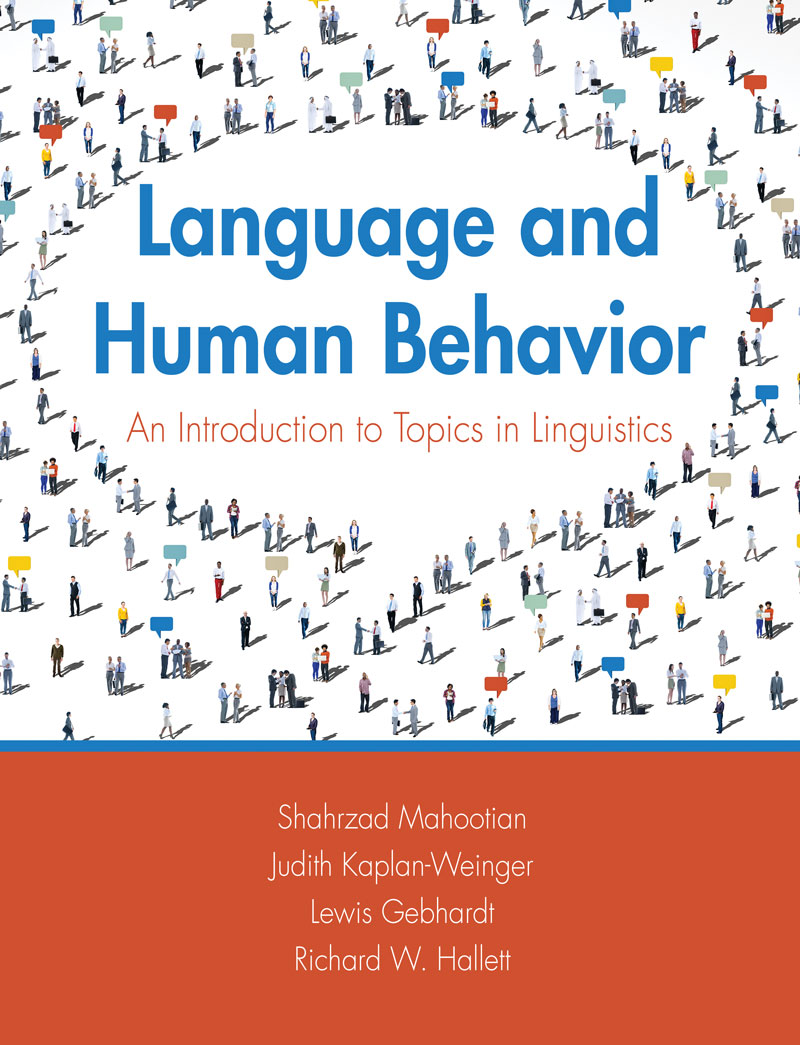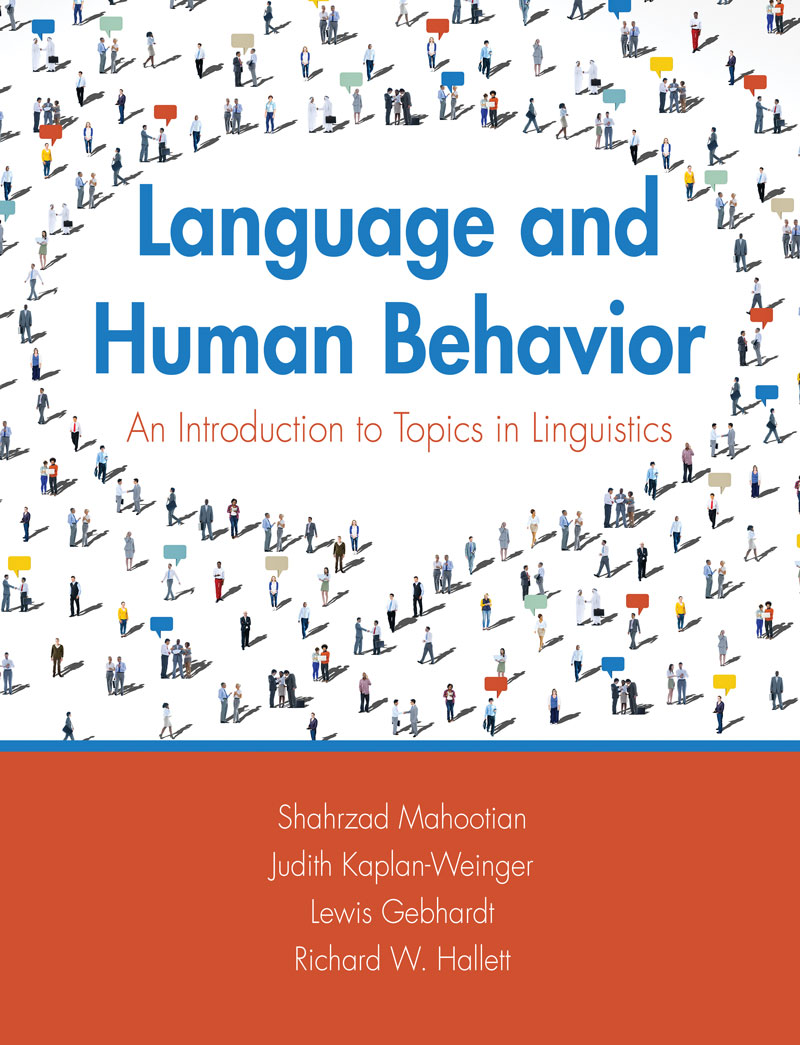Language and Human Behavior: An Introduction to Topics in Linguistics
Author(s): Shahrzad Mahootian , Judith Kaplan-Weinger , Lewis Gebhardt , Richard W. Hallett
Edition: 1
Copyright: 2017
Pages: 300
Edition: 1
Copyright: 2017
Pages: 300
Language and Human Behavior: An Introduction to Topics in Linguistics explores language in an accessible way from an applied linguistics perspective. Specifically, students are introduced to the forms, social varieties, and functions of language, and how language is acquired, is organized in the brain, changes over time, and is sometimes lost. As no previous knowledge of linguistics is required, the book is ideal for general education courses and can also serve as an introduction to the field for undergraduate minors or majors.
The book comprises nine themed sections. Each of the sections includes a number of short, topically relevant chapters, and original exercises, projects, and links to videos and audio excerpts that coordinate with and enliven the chapter topics. These exercises and projects provide opportunities for students to develop critical thinking and writing skills while exploring linguistic topics, and to learn more about their own and their communities’ knowledge and use of language.
Each chapter is organized as follows:
- Prereading questions to frame the topic
- Topic
- List of chapter key words
- Postreading questions to review the chapter
- Questions that stimulate critical thinking in small-group and whole-class discussions
- Chapter references
- List of readings such as academic articles and books, novels and short stories, and/or links to websites, films, and videos that highlight some aspect of the topic presented in the chapter
Additionally, each section includes interviews with linguists who discuss what drew them to the field and their perspectives on language.
Introduction
Authors
Acknowledgements
Section 1. What is Language and How Do We Study It?
Chapter 1.1 How Do We Know What We Know About Languages?
Chapter 1.2 What Do Native Speakers Know About Language?
Chapter 1.3 What Are the Components of Language?
Chapter 1.4 Sign Language
Chapter 1.5 Language in Society
Chapter 1.6 Written Language
Section 2. Origins of Human Language
Chapter 2.1 How Old is Human Language? Facts and Hypotheses
Section 3. A World of Languages
Chapter 3.1 The World’s Languages and Language Families
Chapter 3.2 How Languages Change Over Time
Section 4. Brain, Babies, and Language Learning
Chapter 4.1 Language and the Brain
Chapter 4.2 How Do Children Learn Their First Language?
Chapter 4.3 Is Learning a Second Language Like Learning the First?
Section 5. Language Contact
Chapter 5.1 Language Contact and Multilingualism
Chapter 5.2 World Englishes
Chapter 5.3 Indigenous Languages and Endangered Languages
Section 6. Language and Interaction
Chapter 6.1 Language Varieties
Chapter 6.2 Cultural Competence
Chapter 6.3 It’s a Matter of Style
Chapter 6.4 Taboos, Euphemisms, and Political Correctness
Section 7. Language and Identity
Chapter 7.1 Constructing Identity: Personal, Social, National
Chapter 7.2 Language and Gender
Section 8. Language and Power
Chapter 8.1 Language and Discrimination
Chapter 8.2 Language and Propaganda
Section 9. Language and Social Networks
Chapter 9.1 Txting, Tweeting, -ing
Shahrzad Mahootian is a professor of linguistics in the Department of Linguistics at Northeastern Illinois University. She received her doctorate in linguistics from Northwestern University and began teaching at NEIU in 1993. Her research interests and publications include topics in language contact including structural, cognitive, and social aspects of multilingualism, bilingual language acquisition, code switching and language choice, language and identity. She has also written on various aspects of Persian linguistics.
Judith Kaplan-Weinger is a professor of linguistics in the Department of Linguistics at Northeastern Illinois University. She received her PhD in linguistics from Georgetown University and has been a member of NEIU’s Linguistics faculty since 1987. Her research and teaching focus on sociolinguistics, discourse analysis, and the ethnography of communication. Currently, she researches the discursive practices of loss, grief, and mourning.
Lewis Gebhardt is an assistant professor of linguistics in the Department of Linguistics at Northeastern Illinois University. He earned his PhD at Northwestern University in 2009. His research interests include syntax and semantics, especially the syntax and semantics of noun phrases across languages. He is a linguistic consultant for The Language Conservancy, helping to document and analyze Crow, a Siouan language spoken in Montana, and with the Crow tribe’s language-education and language-revitalization efforts.
Richard W. Hallett is a professor of linguistics in the Department of Linguistics at Northeastern Illinois University. He received his PhD in linguistics from the University of South Carolina in 2000, the same year he began teaching at NEIU. He regularly teaches introductory linguistics, world Englishes, lexical acquisition, multiple language acquisition, English grammar in the classroom, and language and identity. He has published in the areas of second language acquisition, discourse analysis, multimodal discourse analysis, humor, and language and tourism.
Language and Human Behavior: An Introduction to Topics in Linguistics explores language in an accessible way from an applied linguistics perspective. Specifically, students are introduced to the forms, social varieties, and functions of language, and how language is acquired, is organized in the brain, changes over time, and is sometimes lost. As no previous knowledge of linguistics is required, the book is ideal for general education courses and can also serve as an introduction to the field for undergraduate minors or majors.
The book comprises nine themed sections. Each of the sections includes a number of short, topically relevant chapters, and original exercises, projects, and links to videos and audio excerpts that coordinate with and enliven the chapter topics. These exercises and projects provide opportunities for students to develop critical thinking and writing skills while exploring linguistic topics, and to learn more about their own and their communities’ knowledge and use of language.
Each chapter is organized as follows:
- Prereading questions to frame the topic
- Topic
- List of chapter key words
- Postreading questions to review the chapter
- Questions that stimulate critical thinking in small-group and whole-class discussions
- Chapter references
- List of readings such as academic articles and books, novels and short stories, and/or links to websites, films, and videos that highlight some aspect of the topic presented in the chapter
Additionally, each section includes interviews with linguists who discuss what drew them to the field and their perspectives on language.
Introduction
Authors
Acknowledgements
Section 1. What is Language and How Do We Study It?
Chapter 1.1 How Do We Know What We Know About Languages?
Chapter 1.2 What Do Native Speakers Know About Language?
Chapter 1.3 What Are the Components of Language?
Chapter 1.4 Sign Language
Chapter 1.5 Language in Society
Chapter 1.6 Written Language
Section 2. Origins of Human Language
Chapter 2.1 How Old is Human Language? Facts and Hypotheses
Section 3. A World of Languages
Chapter 3.1 The World’s Languages and Language Families
Chapter 3.2 How Languages Change Over Time
Section 4. Brain, Babies, and Language Learning
Chapter 4.1 Language and the Brain
Chapter 4.2 How Do Children Learn Their First Language?
Chapter 4.3 Is Learning a Second Language Like Learning the First?
Section 5. Language Contact
Chapter 5.1 Language Contact and Multilingualism
Chapter 5.2 World Englishes
Chapter 5.3 Indigenous Languages and Endangered Languages
Section 6. Language and Interaction
Chapter 6.1 Language Varieties
Chapter 6.2 Cultural Competence
Chapter 6.3 It’s a Matter of Style
Chapter 6.4 Taboos, Euphemisms, and Political Correctness
Section 7. Language and Identity
Chapter 7.1 Constructing Identity: Personal, Social, National
Chapter 7.2 Language and Gender
Section 8. Language and Power
Chapter 8.1 Language and Discrimination
Chapter 8.2 Language and Propaganda
Section 9. Language and Social Networks
Chapter 9.1 Txting, Tweeting, -ing
Shahrzad Mahootian is a professor of linguistics in the Department of Linguistics at Northeastern Illinois University. She received her doctorate in linguistics from Northwestern University and began teaching at NEIU in 1993. Her research interests and publications include topics in language contact including structural, cognitive, and social aspects of multilingualism, bilingual language acquisition, code switching and language choice, language and identity. She has also written on various aspects of Persian linguistics.
Judith Kaplan-Weinger is a professor of linguistics in the Department of Linguistics at Northeastern Illinois University. She received her PhD in linguistics from Georgetown University and has been a member of NEIU’s Linguistics faculty since 1987. Her research and teaching focus on sociolinguistics, discourse analysis, and the ethnography of communication. Currently, she researches the discursive practices of loss, grief, and mourning.
Lewis Gebhardt is an assistant professor of linguistics in the Department of Linguistics at Northeastern Illinois University. He earned his PhD at Northwestern University in 2009. His research interests include syntax and semantics, especially the syntax and semantics of noun phrases across languages. He is a linguistic consultant for The Language Conservancy, helping to document and analyze Crow, a Siouan language spoken in Montana, and with the Crow tribe’s language-education and language-revitalization efforts.
Richard W. Hallett is a professor of linguistics in the Department of Linguistics at Northeastern Illinois University. He received his PhD in linguistics from the University of South Carolina in 2000, the same year he began teaching at NEIU. He regularly teaches introductory linguistics, world Englishes, lexical acquisition, multiple language acquisition, English grammar in the classroom, and language and identity. He has published in the areas of second language acquisition, discourse analysis, multimodal discourse analysis, humor, and language and tourism.

